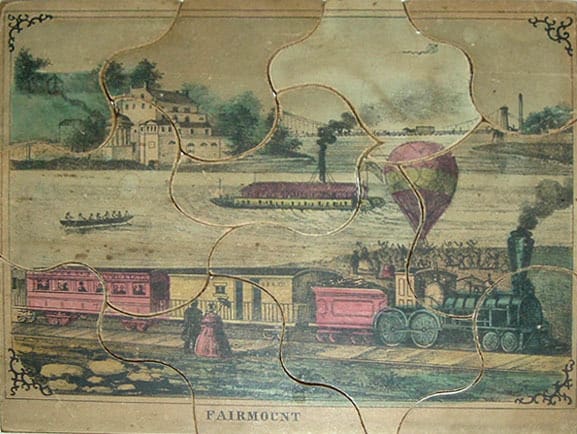Curator‘s Favorite: Jigsaw Puzzles
Hand-colored jigsaw puzzle.

Fairmount, (Philadelphia: Thomas S. Wagner’s Lith., 38 Franklin Place, ca. 1859).
An amusement for the hand and mind, jigsaw puzzles have educated and entertained children (and adults) since the eighteenth century. First issued in Europe as educational “dissected maps,” puzzles evolved into picture toys by the mid-nineteenth century. The Print and Photograph Department holds this one, part of a set of four, published about 1859 by premier Philadelphia lithographer Thomas S. Wagner. It shows Fairmount, which had been designated a park in 1855.
The puzzle, composed of a hand-colored lithograph pasted on a wood board that was then cut by a jig saw, depicts a day of leisure at the park. Important landmarks fill the scene. A couple waits to board a car of the Reading & Columbia Railroad, the Philadelphia railway completed in 1834. A barge and a row boat transport passengers past the Wire Suspension Bridge in Fairmount, the first suspension bridge in the United States, spanning the Schuylkill River since 1842. A hot air balloon makes its ascent from the banks of the river. A group of cheering children and their adult chaperones gather together and watch this nineteenth-century form of entertainment. Across from the frivolity, the Fairmount Water Works is visible. This tourist attraction and water processing facility, built in 1812-1822 after the designs of Philadelphia engineer Frederick Graff, stands in the distance, not yet altered with a new mill house built 1859-1862.
Wagner, one of the earliest American publishers of picture puzzles, issued a view that taught young puzzle players about the built environment of the city as they assembled a lively scene of the new park. Wagner’s workshop, first opened in 1840, produced all types of lithographs in addition to children’s puzzles, including, advertisements, certificates, and views to be framed.
Following the Civil War, the production and popularity of jigsaw puzzles increased and became the niche of a few select companies, like Milton Bradley. Improved technologies and cost-saving measures in the cutting, packaging, and marketing of the puzzles made them appealing to adults as well as children.
Erika Piola, Visual Materials Cataloguer
